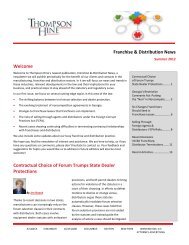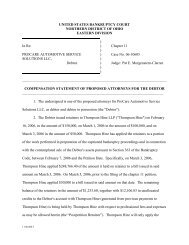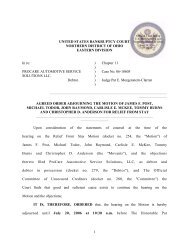Alice In Pharmaland: The “Curiouser And Curiouser” Case Of Conte ...
Alice In Pharmaland: The “Curiouser And Curiouser” Case Of Conte ...
Alice In Pharmaland: The “Curiouser And Curiouser” Case Of Conte ...
You also want an ePaper? Increase the reach of your titles
YUMPU automatically turns print PDFs into web optimized ePapers that Google loves.
<strong>Alice</strong> <strong>In</strong> <strong>Pharmaland</strong>: <strong>The</strong> <strong>“Curiouser</strong> <strong>And</strong><br />
<strong>Curiouser”</strong> <strong>Case</strong> <strong>Of</strong> <strong>Conte</strong> v. Wyeth<br />
Z. Ileana Martinez and Leslie J. Suson 4<br />
“It would be so nice if something<br />
made sense for a change.”<br />
– <strong>Alice</strong> from <strong>Alice</strong>’s Adventures in<br />
Wonderland – Lewis Carroll.<br />
“<strong>The</strong> time has come,”<br />
the Plaintiff said,<br />
“to talk of many Torts,<br />
of disregarded precedents<br />
and medicines -- all sorts.”<br />
So begins our trip down the rabbit hole<br />
of juris(im)prudence. <strong>The</strong> one prerequisite<br />
for pursuit of a claim in any product<br />
liability case – that a defendant’s product<br />
must have caused a plaintiff’s injury –<br />
has gone by the wayside, at least in California.<br />
Recently, a California appellate<br />
court recognized a cause of action based<br />
on negligent misrepresentation against<br />
one manufacturer for injuries stemming<br />
from the use of another manufacturer’s<br />
product. Thus, a name-brand manufacturer<br />
of a prescription drug may be held<br />
liable to a plaintiff who never consumed<br />
its product, for alleged negligent misrepresentations<br />
contained in its product<br />
labeling. <strong>Conte</strong> v. Wyeth, <strong>In</strong>c., et al., 85<br />
Cal.Rptr.3d 299 (Cal. Ct. App. 2008),<br />
review denied, <strong>Case</strong> No. S169116, Sup.<br />
Ct. Cal. (Jan. 21, 2009).<br />
<strong>The</strong> facts in <strong>Conte</strong> are similar to a<br />
long line of cases preceding it. For a<br />
period of almost four years, <strong>Conte</strong>’s<br />
physician prescribed metoclopramide<br />
to treat her gastroesophageal reflux<br />
disease. Wyeth marketed and manufactured<br />
metoclopramide under the name<br />
brand Reglan®. Metoclopramide was<br />
also available in its generic form and<br />
was manufactured by Purepac Pharma-<br />
Winter 2009<br />
ceutical Company, Teva Pharmaceutical<br />
USA, <strong>In</strong>c. and Pliva, <strong>In</strong>c. During the<br />
time <strong>Conte</strong> took metoclopramide, she<br />
purchased and ingested only the generic<br />
form of the drug. <strong>Conte</strong> claimed that<br />
her long-term use of metoclopramide<br />
caused her to develop tardive dyskinesia,<br />
a debilitating and incurable neurological<br />
disorder. She sued Purepac, Teva, and<br />
Pliva, the manufacturers of the generic<br />
metoclopramide she ingested. Although<br />
<strong>Conte</strong> never ingested Wyeth’s Reglan®,<br />
she also named Wyeth as a defendant in<br />
her lawsuit. <strong>Conte</strong> alleged that the product<br />
labeling for metoclopramide and<br />
Reglan® provided by the defendants<br />
did not adequately warn of the risks associated<br />
with long-term use of metoclopramide.<br />
Id. at 305.<br />
<strong>Conte</strong> sought to hold Wyeth liable<br />
for fraud, fraud by concealment and<br />
negligent misrepresentation, based on<br />
the alleged inadequacy of the warnings<br />
accompanying Reglan®. Id. at<br />
305. <strong>Conte</strong> asserted that Wyeth could<br />
be liable because “a name-brand manufacturer<br />
that disseminates information<br />
about its product owes a duty of care<br />
to ensure the information’s accuracy to<br />
any doctor who prescribes the drug in<br />
reasonable reliance on that information,<br />
even if the patient ends up taking the<br />
name-brand product’s generic equivalent.”<br />
Id. at 309.<br />
Although the Plaintiff in <strong>Conte</strong> is not<br />
the first generic-consuming plaintiff to<br />
have raised the negligent misrepresentation<br />
argument against a name-brand<br />
manufacturer, no court – until now –<br />
has ever allowed the claim to proceed. 5<br />
<strong>In</strong> a departure from every jurisdiction to<br />
Rx for the Defense<br />
have considered the issue, the California<br />
Court of Appeals in <strong>Conte</strong> reversed the<br />
trial court’s findings in favor of Wyeth<br />
and concluded that Wyeth did owe a<br />
duty of care to <strong>Conte</strong>, even if her alleged<br />
injuries were caused by another manufacturer’s<br />
product. 6<br />
According to the California Court of<br />
Appeals, Wyeth should reasonably have<br />
perceived that there could be injurious<br />
reliance on its product information by a<br />
patient taking generic metoclopramide.<br />
<strong>The</strong> <strong>Conte</strong> court did not view this conclusion<br />
as a departure from California<br />
law. Rather, in the court’s view, it simply<br />
applied the general rule in California<br />
that “all persons have a duty to use ordinary<br />
care to prevent others from being<br />
injured as a result of their conduct.” Id.<br />
at 311. <strong>The</strong> court relied on the Restatement<br />
Second of Torts, sections 310 and<br />
311, focusing on the foreseeability of<br />
physical harm, and emphasized that<br />
the case was not one involving product<br />
liability principles, but rather, one<br />
involving common law principles of<br />
negligent misrepresentation. According<br />
to the court’s holding, liability could be<br />
based on Wyeth’s statements regarding<br />
Reglan®, and not on a claim regarding<br />
the product it manufactured: “[w]e are<br />
not marking out new territory by recognizing<br />
that a defendant who authors<br />
and disseminates information about a<br />
product manufactured and sold by another<br />
may be liable for negligent misrepresentation<br />
where the defendant should<br />
reasonably expect others to rely on that<br />
information and the product causes injury,<br />
even though the defendant would<br />
not be liable in strict products liability<br />
because it did not manufacture or sell<br />
21
the product. . . . We perceive no logical<br />
or legal inconsistency between allowing<br />
the suit for negligence and disallowing<br />
the suit for strict products liability.” Id.<br />
<strong>The</strong> <strong>Conte</strong> court criticized the reasoning<br />
of Foster v. American Home<br />
Products Corp., 29 F.3d 165 (4th Cir.<br />
1994), the seminal case holding that a<br />
name-brand drug manufacturer cannot<br />
be held liable on a negligent misrepresentation<br />
theory for injuries resulting<br />
from the use of another manufacturer’s<br />
product. <strong>In</strong> Foster, the Fourth Circuit<br />
Court of Appeals rejected the plaintiff’s<br />
contention that Wyeth, the manufacturer<br />
of Phenergan®, owed a duty to the<br />
plaintiffs because it was foreseeable that<br />
misrepresentations regarding Wyeth’s<br />
Phenergan® could result in personal injury<br />
to users of generic equivalents. <strong>The</strong><br />
Foster court stated, “we think to impose<br />
a duty in the circumstances of this case<br />
would be to stretch the concept of foreseeability<br />
too far.” Id. at 171.<br />
<strong>In</strong> rejecting the Foster court’s analysis<br />
(and by implication every opinion addressing<br />
the issue after Foster), the <strong>Conte</strong><br />
court dismissed the notion that the<br />
plaintiff’s negligent misrepresentation<br />
claim was an attempted end-run around<br />
the long-standing requirement of product<br />
liability law that a plaintiff must, as<br />
a threshold requirement, establish that<br />
the defendant made the product she<br />
ingested, and which allegedly caused her<br />
harm.<br />
<strong>The</strong> <strong>Conte</strong> court also addressed, but<br />
refused to be swayed by, the various<br />
policy considerations that have repeatedly<br />
been raised by name-brand manufacturers<br />
faced with a claim for liability<br />
related to a plaintiff’s use of a generic<br />
drug that it did not manufacture. One<br />
of the most compelling policy considerations<br />
is the extraordinary impact that<br />
the <strong>Conte</strong> court’s imposition of the duty<br />
to warn has on name-brand pharmaceutical<br />
manufacturers. A name-brand<br />
manufacturer of a prescription drug may<br />
be held liable to a plaintiff who never<br />
consumed its product, for alleged negligent<br />
misrepresentations contained in its<br />
product labeling. <strong>In</strong> effect, the holding<br />
in <strong>Conte</strong> means that name-brand manufacturers<br />
may be held responsible for<br />
any injuries, to any plaintiffs, caused<br />
by any generic drug made by other<br />
manufacturers, if the prescribing physician<br />
relied on the name-brand manufacturers’<br />
product labeling. 7 For obvious<br />
reasons, this result has been described by<br />
other courts faced with the same issue as<br />
an “exotic” theory of liability, “new and<br />
uncharted territory,” and an “unprecedented<br />
departure” from traditional tort<br />
law. <strong>The</strong> <strong>Conte</strong> court’s response: “these<br />
dire consequences are neither self-evident<br />
nor substantiated by the record.”<br />
<strong>Conte</strong>, 85 Cal.Rptr.3d at 317.<br />
Another important policy consideration<br />
is the time and expense invested<br />
by pioneer manufacturers in the development<br />
and marketing of new drugs.<br />
To market a new drug, a name-brand<br />
manufacturer must file a New Drug Application<br />
(“NDA”) with the Food and<br />
Drug Administration (“FDA”), which<br />
must include, among other things, full<br />
reports of investigations made of the<br />
drug’s safety and effectiveness, a full list<br />
of the drug’s components, a full statement<br />
of the drug’s composition, a full<br />
description of the methods, facilities<br />
and controls used for the drug’s manufacturing,<br />
processing and packing, and<br />
“specimens of the labeling proposed to<br />
be used for such drug.” 21 U.S.C. §<br />
355(b)(1). Estimates for the time and<br />
cost invested by a name-brand manufacturer<br />
for bringing a new prescription<br />
drug to market are upwards of 10 years<br />
and $800 million dollars (in year 2000<br />
dollars). 8 Given the explosion in R&D<br />
and other costs since then, estimates of<br />
the current costs borne by a name-brand<br />
manufacturer to bring a new drug to<br />
market are in excess of $970 million. 9<br />
Pursuant to <strong>The</strong> Drug Price Competition<br />
and Patent Term Restoration<br />
Act of 1984 (“Hatch-Waxman Amendments”),<br />
generic drug manufacturers can<br />
file an Abbreviated New Drug Application<br />
(“ANDA”) and must merely show<br />
that its generic version is bioequivalent<br />
to an already approved drug, 21 U.S.C.<br />
355(j)(2)(A)(iv), and that “the labeling<br />
proposed for the generic drug is the<br />
same as the labeling approved for the<br />
listed drug.” 21 U.S.C. 355(j)(2)(A)(v).<br />
A generic manufacturer’s ANDA need<br />
not contain independent reports or<br />
investigations of the drug’s safety and<br />
effectiveness, and the generic manufacturer<br />
is allowed to rely upon the safety<br />
and effectiveness evidence presented by<br />
the original manufacturer in its NDA.<br />
Courts repeatedly have recognized<br />
the intent behind the Hatch-Waxman<br />
Amendments: to motivate name-brand<br />
drug manufacturers to devote resources<br />
toward new drugs, and, concurrently, to<br />
allow their competitors to provide more<br />
economical generic options to consumers.<br />
Thus, name-brand manufacturers undertake<br />
the time and expense to develop<br />
new drugs, yet once patent protection<br />
has expired, manufacturers of generics<br />
can immediately begin to sell their drugs<br />
by simply replicating the name-brand<br />
drugs, bypassing the enormous development<br />
expense, and benefiting from the<br />
association with, and advertising about,<br />
the name-brand drug. Given the undertaking<br />
by pioneer manufacturers, and<br />
the benefit to generic competitors, the<br />
holding in <strong>Conte</strong> imposing liability on<br />
the name-brand manufacturer for the<br />
22 Rx for the Defense Winter 2009
warnings used by the generic manufacturer<br />
is manifestly unfair and inconsistent<br />
with apparent Congressional intent.<br />
Neither the Hatch-Waxman Amendments<br />
nor the statutory drug application<br />
process include any indication that<br />
name-brand manufacturers are to be<br />
liable for injuries caused by the generic<br />
form of a drug manufactured by another<br />
company.<br />
Even the court in <strong>Conte</strong> recognized<br />
that the generic manufacturer is responsible<br />
for the information it disseminates<br />
to consumers of its products, and the<br />
copycat manufacturer is not bound by<br />
the name-brand label. Generic manufacturers<br />
have the ability to “add or<br />
strengthen a contraindication, warning,<br />
precaution, or adverse reaction” or<br />
“delete false, misleading or unsupported<br />
indication for use.” Colacicco v. Apotex,<br />
<strong>In</strong>c., 432 F. Supp. 2d 514, 523 (E.D. Pa.<br />
2006); see 21 C.F.R. §§ 314.70, 314.80.<br />
As the Foster court stated: “[w]e do not<br />
accept the assertion that a generic manufacturer<br />
is not responsible for negligent<br />
misrepresentation on its product labels<br />
if it did not initially formulate the warnings<br />
and representations itself. When<br />
a generic manufacturer adopts a namebrand<br />
manufacturer’s warnings and<br />
representations without independent<br />
investigation, it does so at the risk that<br />
such warnings and representations may<br />
be flawed.” Foster, 29 F.3d at 169-70.<br />
<strong>In</strong> <strong>Conte</strong>, there was no evidence that<br />
the prescribing physician ever read any<br />
warnings or product information disseminated<br />
by the generic manufacturers.<br />
However, if the generic manufacturers<br />
disseminated the exact same labeling<br />
information as Wyeth and chose not to<br />
strengthen or change the labeling used<br />
Winter 2009<br />
to sell their generic products (assuming<br />
<strong>Conte</strong> is correct that such changes were<br />
necessary), and <strong>Conte</strong> took only the generic<br />
form of the drug, where is the fairness<br />
in keeping Wyeth in the case, yet<br />
dismissing the generic manufacturers?<br />
Faced with these policy considerations,<br />
and the unfairness of allowing<br />
misrepresentation actions against namebrand<br />
manufacturers, the <strong>Conte</strong> court<br />
pointed to “countervailing factors,” such<br />
as the “unique advantages” enjoyed by<br />
the new drug innovator, including “the<br />
initial period of patent-protection from<br />
competition, the fiscal rewards of namebrand<br />
recognition, and the commensurate<br />
ability to charge a higher price for<br />
its product, even after its exclusive marketing<br />
position expires.” <strong>Conte</strong>, 85 Cal.<br />
Rptr.3d at 317.<br />
<strong>The</strong> impact of <strong>Conte</strong> on the pharmaceutical<br />
industry is yet to be seen, but it<br />
is a given that some impact is predictable,<br />
notwithstanding the <strong>Conte</strong> court’s<br />
position that it was “unpersuaded by<br />
Wyeth’s assertion that imposing liability<br />
would undermine the goal of preventing<br />
future harm because it would chill<br />
innovation in the pharmaceutical industry.”<br />
<strong>Conte</strong>, 85 Cal.Rptr.3d at 314. It<br />
cannot seriously be disputed that the<br />
potential cost of liability to innovator<br />
drug manufacturers for every alleged<br />
injury by every equivalent generic drug<br />
would be enormous. As explained in<br />
one opinion addressing the issue, courts<br />
“have recognized the societal importance<br />
of new and effective prescription drugs .<br />
. . [and] the need not to unduly burden<br />
the pharmaceutical industry with unfettered<br />
liability.” Colacicco, 432 F. Supp.<br />
at 542. . <strong>The</strong> cost, ultimately, will be<br />
placed at the feet of the consumer who<br />
Rx for the Defense<br />
will have to pay higher prices for the<br />
new drug during that “initial period<br />
of patent-protection.” <strong>Conte</strong>, 85 Cal.<br />
Rptr.3d at 317.<br />
<strong>Conte</strong>’s expansion of the “general<br />
duty to use due care in disseminating<br />
product information to those [whom<br />
the manufacturer] . . . knows or should<br />
know are likely to be harmed as a<br />
result of the consumer’s reliance on<br />
that information” poses a serious and<br />
threatening departure from product liability<br />
law as it currently exists. <strong>And</strong><br />
arguably, the threat is not limited to the<br />
pharmaceutical industry, as plaintiffs<br />
suing other product manufacturer’s will<br />
likely cite the <strong>Conte</strong> opinion in support<br />
of their negligent misrepresentation<br />
claims. <strong>Conte</strong>’s vast interpretation of a<br />
manufacturer’s “duty” and “foreseeability”<br />
means, in effect, that in California<br />
(and soon coming to a court near you),<br />
any consumer may rely on and sue a<br />
manufacturer who is the first to dispense<br />
product information and warnings in<br />
any given industry, regardless of whether<br />
that manufacturer’s product was used by<br />
the plaintiff consumer.<br />
<strong>The</strong> Mock Turtle in <strong>Alice</strong>’s Adventures<br />
in Wonderland must certainly<br />
have been reading the <strong>Conte</strong> v. Wyeth<br />
decision when he said, “I never heard it<br />
before, but it sounds uncommon nonsense.”<br />
Moreover, since the California<br />
Supreme Court has declined to review<br />
the <strong>Conte</strong> decision, 10 it appears that Wyeth’s<br />
and other name-brand manufacturer’s<br />
only relief from this “uncommon<br />
nonsense” might lie in the hands of the<br />
United States Supreme Court.<br />
23







